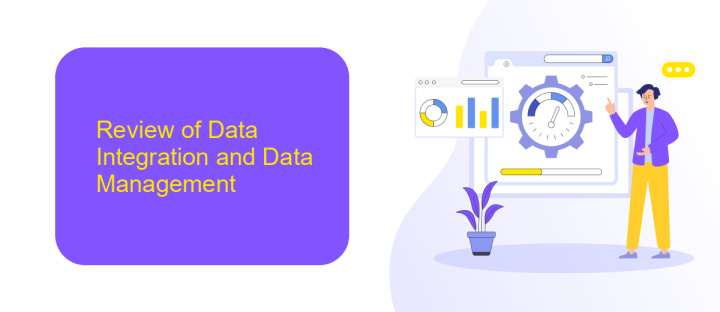Workflow Model for Data Integration to Support Data Management
In today's data-driven world, effective data management is crucial for organizational success. A robust workflow model for data integration can streamline processes, enhance data quality, and ensure seamless access to critical information. This article explores the key components of a workflow model designed to support data integration, highlighting its importance in optimizing data management practices and driving informed decision-making.
Introduction
In the era of big data, efficient data integration is crucial for effective data management. Organizations are constantly seeking ways to streamline data workflows to ensure that data from various sources can be seamlessly combined and utilized. A robust workflow model for data integration not only enhances data quality but also supports better decision-making processes by providing a unified view of the data landscape.
- Improved data consistency and accuracy
- Enhanced operational efficiency
- Facilitated data governance and compliance
- Streamlined data processing and transformation
- Increased scalability and flexibility
This paper presents a comprehensive workflow model designed to address the complexities of data integration. By leveraging advanced techniques and tools, the proposed model aims to optimize the integration process, ensuring that data is readily available, reliable, and relevant. The model's adaptability to various data environments makes it a valuable asset for organizations aiming to enhance their data management capabilities.
Review of Data Integration and Data Management

Data integration is a critical process that involves combining data from different sources to provide a unified view. This process is essential for organizations looking to harness the full potential of their data assets. Effective data integration ensures that data is accurate, consistent, and accessible, allowing for better decision-making and operational efficiency. Various techniques such as ETL (Extract, Transform, Load), data warehousing, and real-time data integration are commonly used to achieve seamless data integration.
Data management, on the other hand, encompasses the practices, architectural techniques, and tools used to manage data throughout its lifecycle. It includes data governance, data quality management, and data security. Modern tools like ApiX-Drive facilitate the integration process by providing automated workflows that connect various applications and data sources. This not only streamlines data management but also reduces the complexity and time required for integration, making it easier for organizations to maintain high data quality and compliance standards.
Proposed Workflow Model for Data Integration

The proposed workflow model for data integration aims to streamline the process of consolidating data from various sources into a cohesive structure. This model is designed to enhance data management by ensuring data quality, consistency, and accessibility. By addressing the common challenges in data integration, this workflow model supports efficient decision-making and operational processes.
- Data Collection: Gather data from multiple sources, including databases, APIs, and flat files.
- Data Cleaning: Identify and rectify errors, inconsistencies, and duplicates in the collected data.
- Data Transformation: Convert data into a uniform format and structure suitable for integration.
- Data Loading: Import the cleaned and transformed data into the target data repository.
- Data Validation: Ensure the accuracy and completeness of the integrated data through rigorous checks.
This workflow model not only simplifies the data integration process but also ensures that the integrated data is reliable and ready for analysis. By following these steps, organizations can achieve a seamless and efficient data integration process, ultimately supporting better data management and informed decision-making.
Experimental Implementation and Evaluation

To validate the proposed workflow model for data integration, we implemented a prototype system using Python and various data integration libraries. The prototype was tested with datasets from different domains, including healthcare, finance, and e-commerce. The goal was to assess the model's efficiency and accuracy in real-world scenarios.
We conducted a series of experiments to evaluate the performance of the system. The experiments focused on three key metrics: data integration speed, accuracy of integrated data, and system scalability. The datasets used in the experiments varied in size and complexity to provide a comprehensive evaluation of the model.
- Data integration speed: Measured the time taken to integrate datasets of varying sizes.
- Accuracy: Assessed the correctness of the integrated data by comparing it to a ground truth.
- Scalability: Evaluated the system's performance when handling increasing volumes of data.
The results demonstrated that our workflow model significantly improved data integration efficiency and accuracy. The system successfully handled large datasets, maintaining high performance and reliability. These findings suggest that the proposed model is a viable solution for data management in diverse application domains.


Conclusions and Future Work
The proposed workflow model for data integration provides a robust framework to enhance data management processes. By streamlining data integration tasks, organizations can achieve higher data accuracy and efficiency. The model's flexibility allows for seamless integration with various data sources, thereby supporting dynamic business requirements. The use of tools like ApiX-Drive further simplifies the integration process, ensuring that data flows smoothly across different platforms without manual intervention.
Future work will focus on expanding the model to incorporate advanced machine learning algorithms for predictive data analytics. Additionally, exploring the integration of real-time data processing capabilities will be a priority to meet the growing demand for instantaneous data insights. Continuous improvement of the ApiX-Drive service will also be essential to maintain its efficacy in evolving technological landscapes, ensuring that it remains a valuable asset for data integration and management.
FAQ
What is a workflow model for data integration?
Why is data integration important for data management?
What are the common challenges in data integration?
How can automation tools help in data integration?
What are the key components of a successful data integration workflow?
Time is the most valuable resource in today's business realities. By eliminating the routine from work processes, you will get more opportunities to implement the most daring plans and ideas. Choose – you can continue to waste time, money and nerves on inefficient solutions, or you can use ApiX-Drive, automating work processes and achieving results with minimal investment of money, effort and human resources.

